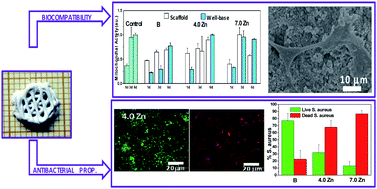In vitro antibacterial capacity and cytocompatibility of SiO2–CaO–P2O5 meso-macroporous glass scaffolds enriched with ZnO†
Abstract
Zn2+ ions exhibit osteogenic, angiogenic and antimicrobial properties. For this reason, they are often added in small amounts to bioceramics being investigated for bone tissue engineering. In this paper, the cytocompatibility and antibacterial properties of 80% SiO2–15% CaO–5% P2O5 (mol%) mesoporous bioactive glass (MBG) scaffolds substituted with 4.0% and 7.0% of ZnO were studied and compared with the Zn-free scaffold. Cell proliferation, morphology, differentiation and cytotoxic effects of Zn2+ ions released from the samples were examined by culturing human osteoblast-like cells (HOS) osteoblasts both in the presence of sample extracts and on the scaffold surface. The bacterial inhibition capacity of the scaffolds was explored by using Gram-positive Stapylococcus aureus bacteria, responsible for numerous infections in orthopedic surgery, to simulate a severe infection. Our results show that the Zn–MBG scaffolds possess a hierarchical meso-macropore structure suitable for osteoblast growth. Furthermore, the amount of Zn2+ released from the scaffold with 4.0% ZnO was found to be more favorable for HOS cell development than that released from the scaffold including 7.0% ZnO. Zn2+ released to the medium from both scaffolds exhibited antibacterial properties against S. aureus. Thus, the cytocompatibility and the antibacterial ability exhibited by the MBG scaffold containing 4.0% ZnO make it a suitable candidate for bone regeneration applications.


 Please wait while we load your content...
Please wait while we load your content...